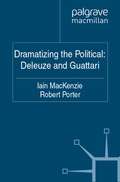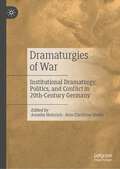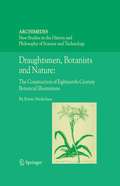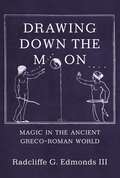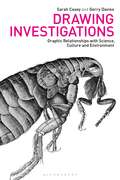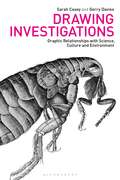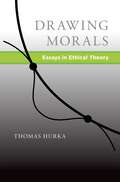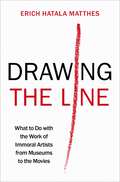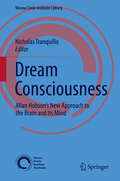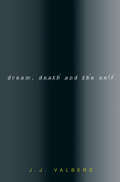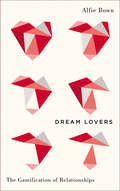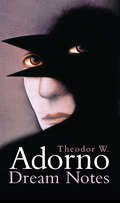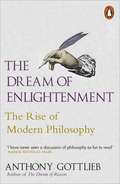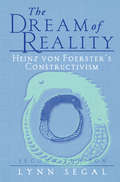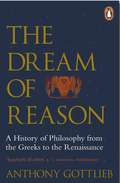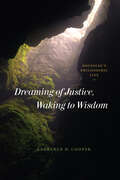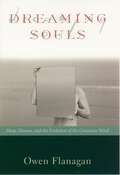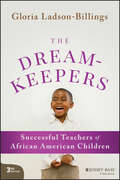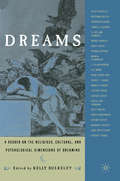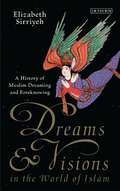- Table View
- List View
Dramatizing the Political: Deleuze and Guattari
by I. MacKenzie R. PorterThis is an in-depth analysis of dramatization as method in the work of Deleuze and Guattari. It provides an account of the value of this method for the study of the political with particular emphasis on the relationship between politics and art.
Dramaturgies of War: Institutional Dramaturgy, Politics, and Conflict in 20th-Century Germany
by Anselm Heinrich Ann-Christine SimkeThis book examines the institutional contexts of dramaturgical practices in the changing political landscape of 20th century Germany. Through wide-ranging case studies, it discusses the way in which operationalised modes of action, legal frameworks and an established profession have shaped dramaturgical practice and thus links to current debates around the “institutional turn” in theatre and performance studies. German theatre represents a rich and well-chosen field as it is here where the role of the dramaturg was first created and where dramaturgy played a significantly politicised role in the changing political systems of the 20th century. The volume represents an important addition to a growing field of work on dramaturgy by contributing to a historical contextualisation of current practice. In doing so, it understands dramaturgy not only as a process which occurs in rehearsal rooms and writers’ studies, but one that has far wider institutional and political implications.
Draughtsmen, Botanists and Nature: The Construction of Eighteenth-Century Botanical Illustrations (Archimedes #15)
by Kärin NickelsenThis book is the first in-depth study of eighteenth-century botanical illustrations. Its findings offer a completely new insight into the working practices of the botanists and scientific draughtsmen of this period. The author describes the different production stages of these illustrations. For the first time, the author presents a convincing description of how botanical illustrations developed, ascertaining the criteria that drove this process.
Drawing Down the Moon: Magic in the Ancient Greco-Roman World
by III Radcliffe G. Edmonds IIIAn unparalleled exploration of magic in the Greco-Roman worldWhat did magic mean to the people of ancient Greece and Rome? How did Greeks and Romans not only imagine what magic could do, but also use it to try to influence the world around them? In Drawing Down the Moon, Radcliffe Edmonds, one of the foremost experts on magic, religion, and the occult in the ancient world, provides the most comprehensive account of the varieties of phenomena labeled as magic in classical antiquity. Exploring why certain practices, images, and ideas were labeled as “magic” and set apart from “normal” kinds of practices, Edmonds gives insight into the shifting ideas of religion and the divine in the ancient past and in the later Western tradition.Using fresh approaches to the history of religions and the social contexts in which magic was exercised, Edmonds delves into the archaeological record and classical literary traditions to examine images of witches, ghosts, and demons as well as the fantastic powers of metamorphosis, erotic attraction, and reversals of nature, such as the famous trick of drawing down the moon. From prayer and divination to astrology and alchemy, Edmonds journeys through all manner of ancient magical rituals and paraphernalia—ancient tablets, spell books, bindings and curses, love charms and healing potions, and amulets and talismans. He considers the ways in which the Greco-Roman discourse of magic was formed amid the cultures of the ancient Mediterranean, including Egypt and the Near East.An investigation of the mystical and marvelous, Drawing Down the Moon offers an unparalleled record of the origins, nature, and functions of ancient magic.
Drawing Investigations: Graphic Relationships with Science, Culture and Environment (Drawing In)
by Sarah Casey Gerry DaviesUsing close visual analysis of drawings, artist interviews, critical analysis and exegesis, Drawing Investigations examines how artists use drawing as an investigative tool to reveal information that would otherwise remain unseen and unnoticed.How does drawing add shape to ideas? How does the artist accommodate to challenges and restraints of a particular environment? To what extent is a drawing complementary and continuous with its subject and where is it disruptive and provocative? Casey and Davies address these questions while focusing on artists working collaboratively and the use of drawing in challenging or unexpected environments. Drawing Investigations evaluates the emergence of a way of thinking among an otherwise disconnected group of artists by exploring commonalities in the application of analytical drawing to the natural world, urban environment, social forces and lived experience. Examples represent a spectrum of research in international contexts: an oceanographic Institute in California, the archives of Amsterdam's Rijksmuseum, the Antarctic Survey, geothermal research in Japan and the Kurdish diaspora in Iraq. Issues are situated in the contemporary theory and practice of drawing including relationships to historical precedents.By exploring drawing's capacity to capture and describe experience, to sharpen visual faculties and to bridge embodied and conceptual knowledge, Drawing Investigations offers a fresh critical perspective on contemporary drawing practice.
Drawing Investigations: Graphic Relationships with Science, Culture and Environment (Drawing In)
by Sarah Casey Gerry DaviesUsing close visual analysis of drawings, artist interviews, critical analysis and exegesis, Drawing Investigations examines how artists use drawing as an investigative tool to reveal information that would otherwise remain unseen and unnoticed.How does drawing add shape to ideas? How does the artist accommodate to challenges and restraints of a particular environment? To what extent is a drawing complementary and continuous with its subject and where is it disruptive and provocative? Casey and Davies address these questions while focusing on artists working collaboratively and the use of drawing in challenging or unexpected environments. Drawing Investigations evaluates the emergence of a way of thinking among an otherwise disconnected group of artists by exploring commonalities in the application of analytical drawing to the natural world, urban environment, social forces and lived experience. Examples represent a spectrum of research in international contexts: an oceanographic Institute in California, the archives of Amsterdam's Rijksmuseum, the Antarctic Survey, geothermal research in Japan and the Kurdish diaspora in Iraq. Issues are situated in the contemporary theory and practice of drawing including relationships to historical precedents.By exploring drawing's capacity to capture and describe experience, to sharpen visual faculties and to bridge embodied and conceptual knowledge, Drawing Investigations offers a fresh critical perspective on contemporary drawing practice.
Drawing Morals: Essays in Ethical Theory (Oxford Moral Theory)
by Thomas HurkaThis volume contains selected essays in moral and political philosophy by Thomas Hurka. The essays address a wide variety of topics, from the well-rounded life and the value of playing games to proportionality in war and the ethics of nationalism. They also share a common aim: to illuminate the surprising richness and subtlety of our everyday moral thought by revealing its underlying structure, which they often do by representing that structure on graphs. More specifically, the essays all give what the first in the volume calls "structural" as against "foundational" analyses of moral views. Eschewing the grander ambition of grounding our ideas about, say, virtue or desert in claims that use different concepts and concern some other, allegedly more fundamental topic, they examine these ideas in their own right and with close attention to their details. As well as illuminating their individual topics, the essays illustrate the insights this structural method can yield.
Drawing Morals: Essays in Ethical Theory (Oxford Moral Theory)
by Thomas HurkaThis volume contains selected essays in moral and political philosophy by Thomas Hurka. The essays address a wide variety of topics, from the well-rounded life and the value of playing games to proportionality in war and the ethics of nationalism. They also share a common aim: to illuminate the surprising richness and subtlety of our everyday moral thought by revealing its underlying structure, which they often do by representing that structure on graphs. More specifically, the essays all give what the first in the volume calls "structural" as against "foundational" analyses of moral views. Eschewing the grander ambition of grounding our ideas about, say, virtue or desert in claims that use different concepts and concern some other, allegedly more fundamental topic, they examine these ideas in their own right and with close attention to their details. As well as illuminating their individual topics, the essays illustrate the insights this structural method can yield.
Drawing the Line: What to Do with the Work of Immoral Artists from Museums to the Movies
by Erich Hatala MatthesCan we still watch Woody Allen's movies? Can we still laugh at Bill Cosby's jokes? Woody Allen, Kevin Spacey, Dave Chappelle, Louis C. K., J.K. Rowling, Michael Jackson, Roseanne Barr. Recent years have proven rife with revelations about the misdeeds, objectional views, and, in some instances, crimes of popular artists. Spurred in part by the #metoo movement, and given more access than ever thanks to social media and the internet in general, the public has turned an alert and critical eye upon the once-hidden lives of previously cherished entertainers. But what should we members of the public do, think, and feel in response to these artists' actions or statements? It's a predicament that many of us face: whether it's possible to disentangle the deeply unsettled feelings we have toward an artist from how we respond to the art they produced. As consumers of art, and especially as fans, we have a host of tricky moral question to navigate: do the moral lives of artists affect the aesthetic quality of their work? Is it morally permissible for us to engage with or enjoy that work? Should immoral artists and their work be "canceled"? Most of all, can we separate an artist from their art? In Drawing the Line, Erich Hatala Matthes employs the tools of philosophy to offer insight and clarity to the ethical questions that dog us. He argues that it doesn't matter whether we can separate the art from the artist, because we shouldn't. While some dismiss the lives of artists as if they are irrelevant to the artist's work, and others instrumentalize artwork, treating it as nothing more than a political tool, Matthes argues both that the lives of artists can play an important role in shaping our moral and aesthetic relationship to the artworks that we love and that these same artworks offer us powerful resources for grappling with the immorality of their creators. Rather than shunning art made by those who have been canceled, shamed, called out, or even arrested, we should engage with it all the more thoughtfully and learn from the complexity it forces us to confront. Recognizing the moral and aesthetic relationships between art and artist is crucial to determining when and where we should draw the line when good artists do bad things.
Drawing the Line: What to Do with the Work of Immoral Artists from Museums to the Movies
by Erich Hatala MatthesCan we still watch Woody Allen's movies? Can we still laugh at Bill Cosby's jokes? Woody Allen, Kevin Spacey, Dave Chappelle, Louis C. K., J.K. Rowling, Michael Jackson, Roseanne Barr. Recent years have proven rife with revelations about the misdeeds, objectional views, and, in some instances, crimes of popular artists. Spurred in part by the #metoo movement, and given more access than ever thanks to social media and the internet in general, the public has turned an alert and critical eye upon the once-hidden lives of previously cherished entertainers. But what should we members of the public do, think, and feel in response to these artists' actions or statements? It's a predicament that many of us face: whether it's possible to disentangle the deeply unsettled feelings we have toward an artist from how we respond to the art they produced. As consumers of art, and especially as fans, we have a host of tricky moral question to navigate: do the moral lives of artists affect the aesthetic quality of their work? Is it morally permissible for us to engage with or enjoy that work? Should immoral artists and their work be "canceled"? Most of all, can we separate an artist from their art? In Drawing the Line, Erich Hatala Matthes employs the tools of philosophy to offer insight and clarity to the ethical questions that dog us. He argues that it doesn't matter whether we can separate the art from the artist, because we shouldn't. While some dismiss the lives of artists as if they are irrelevant to the artist's work, and others instrumentalize artwork, treating it as nothing more than a political tool, Matthes argues both that the lives of artists can play an important role in shaping our moral and aesthetic relationship to the artworks that we love and that these same artworks offer us powerful resources for grappling with the immorality of their creators. Rather than shunning art made by those who have been canceled, shamed, called out, or even arrested, we should engage with it all the more thoughtfully and learn from the complexity it forces us to confront. Recognizing the moral and aesthetic relationships between art and artist is crucial to determining when and where we should draw the line when good artists do bad things.
Dream Consciousness: Allan Hobson’s New Approach to the Brain and Its Mind (Vienna Circle Institute Library #3)
by Nicholas TranquilloThis book presents three lectures by Allan Hobson, entitled “The William James Lectures on Dream Consciousness”. The three lectures expose the new psychology, the new physiology and the new philosophy that derive from and support the protoconsciousness hypothesis of dreaming. They review in detail many of the studies on sleep and dreaming conducted since the days of Sigmund Freud. Following the lectures are commentaries written by scholars whose expertise covers a wide range of scientific disciplines including, but not limited to, philosophy, psychology, neurology, neuropsychology, cognitive science, biology and animal sciences. The commentaries each answer a specific question in relation to Hobson’s lectures and his premise that dreaming is an altered state of consciousness. Capitalizing on a vast amount of data, the lectures and commentaries provide undisputed evidence that sleep consists of a well-organized sequence of subtly orchestrated brain states that undoubtedly play a crucial function in the maintenance of normal brain functions. These functions include both basic homeostatic processes necessary to keep the organism alive as well as the highest cognitive functions including perception, decision making, learning and consciousness.
Dream, Death, and the Self
by J. Valberg"Might this be a dream?" In this book, distinguished philosopher J. J. Valberg approaches the familiar question about dream and reality by seeking to identify its subject matter: what is it that would be the dream if "this" were a dream? It turns out to be a subject matter that contains the whole of the world, space, and time but which, like consciousness for Sartre, is nothing "in itself." This subject matter, the "personal horizon," lies at the heart of the main topics--the first person, the self, and the self in time--explored at length in the book. The personal horizon is, Valberg contends, the subject matter whose center each of us occupies, and which for each of us ceases with death. This ceasing to be presents itself solipsistically not just as the end of everything "for me" but as the end of everything absolutely. Yet since it is the same for everyone, this cannot be. Death thus confronts us with an impossible fact: something that cannot be but will be. The puzzle about death is one of several extraphilosophical puzzles about the self that Valberg discusses, puzzles that can trouble everyday consciousness without any contribution from philosophy. Nor can philosophy resolve the puzzles. Its task is to get to the bottom of them, and in this respect to understand ourselves--a task philosophy has always set itself.
Dream Lovers: The Gamification of Relationships (Digital Barricades)
by Alfie BownWe are in the middle of a 'desirevolution' - a fundamental and political transformation of the way we desire as human beings. Perhaps as always, new technologies - with their associated and inherited political biases - are organising and mapping the future. What we don’t seem to notice is that the primary way in which our lives are being transformed is through the manipulation and control of desire itself. Our very impulses, drives and urges are 'gamified' to suit particular economic and political agendas, changing the way we relate to everything from lovers and friends to food and politicians. Digital technologies are transforming the subject at the deepest level of desire – re-mapping its libidinal economy - in ways never before imagined possible. From sexbots to smart condoms, fitbits to VR simulators and AI to dating algorithms, the 'love industries' are at the heart of the future smart city and the social fabric of everyday life. This book considers these emergent technologies and what they mean for the future of love, desire, work and capitalism.
Dream Notes
by Theodor W. Adorno"Dreams are as black as death." —Theodor W. Adorno Adorno was fascinated by his dreams and wrote them down throughout his life. He envisaged publishing a collection of them although in the event no more than a few appeared in his lifetime. Dream Notes offers a selection of Adornos writings on dreams that span the last twenty-five years of his life. Readers of Adorno who are accustomed to high-powered reflections on philosophy, music and culture may well find them disconcerting: they provide an amazingly frank and uninhibited account of his inner desires, guilt feelings and anxieties. Brothel scenes, torture and executions figure prominently. They are presented straightforwardly, at face value. No attempt is made to interpret them, to relate them to the events of his life, to psychoanalyse them, or to establish any connections with the principal themes of his philosophy. Are they fiction, autobiography or an attempt to capture a pre-rational, quasi-mythic state of consciousness? No clear answer can be given. Taken together they provide a highly consistent picture of a dimension of experience that is normally ignored, one that rounds out and deepens our knowledge of Adorno while retaining something of the enigmatic quality that energized his own thought.
Dream Notes
by Theodor W. Adorno"Dreams are as black as death." —Theodor W. Adorno Adorno was fascinated by his dreams and wrote them down throughout his life. He envisaged publishing a collection of them although in the event no more than a few appeared in his lifetime. Dream Notes offers a selection of Adornos writings on dreams that span the last twenty-five years of his life. Readers of Adorno who are accustomed to high-powered reflections on philosophy, music and culture may well find them disconcerting: they provide an amazingly frank and uninhibited account of his inner desires, guilt feelings and anxieties. Brothel scenes, torture and executions figure prominently. They are presented straightforwardly, at face value. No attempt is made to interpret them, to relate them to the events of his life, to psychoanalyse them, or to establish any connections with the principal themes of his philosophy. Are they fiction, autobiography or an attempt to capture a pre-rational, quasi-mythic state of consciousness? No clear answer can be given. Taken together they provide a highly consistent picture of a dimension of experience that is normally ignored, one that rounds out and deepens our knowledge of Adorno while retaining something of the enigmatic quality that energized his own thought.
The Dream of Enlightenment: The Rise of Modern Philosophy
by Anthony Gottlieb'This is a blast of fresh air' Jonathan Clark, TLS'Thank goodness for Gottlieb' Daily Telegraph'A joy to read' EconomistThe author of the celebrated The Dream of Reason vividly explains the rise of modern thought from Descartes to RousseauWestern philosophy is now two and a half millennia old, but much of it came in just two staccato bursts, each lasting only about 150 years. In his landmark survey of Western philosophy from the Greeks to the Renaissance, The Dream of Reason, Anthony Gottlieb documented the first of these, which came in the Athens of Socrates, Plato, and Aristotle. Now, in The Dream of Enlightenment, Gottlieb expertly navigates the second great explosion of thought, taking us to northern Europe in the wake of its wars of religion and the rise of Galilean science. In a relatively short period - from the early 1640s to the eve of the French Revolution - Descartes, Hobbes, Spinoza, Locke, Leibniz, and Hume all made their mark. The Dream of Enlightenment tells their story and that of the birth of modern philosophy.As Gottlieb explains, all these men were amateurs: none had much to do with any university. They tried to fathom the implications of the new science and of religious upheaval, which led them to question traditional teachings and attitudes. What does the advance of science entail for our understanding of ourselves and for our ideas of God? How should a government deal with religious diversity - and what is government actually for? Such questions remain our questions.Yet it is because we still want to hear them that we can easily get these philosophers wrong. It is tempting to think they speak our language and live in our world; but to understand them properly, we must step back into their shoes. Gottlieb puts readers in the minds of these frequently misinterpreted figures, elucidating the history of their times while engagingly explaining their arguments and assessing their legacy. The Dream of Enlightenment creates a sweeping account of what they amounted to, and why we are still in their debt.
The Dream of Reality: Heinz von Foerster’s Constructivism
by Lynn SegalWhat if there were no objective facts, no objective truth, only our belief in them? What if our consciousness itself is an unconscious invention, constructed out of logic and language? In this thought-provoking volume, Lynn Segal describes how the ideas of Heinz von Foerster compel us to explore the question "Do we discover the world or do we invent it?". He suggests that we must first know how we think before we can claim knowledge of the world. While Constructivism may seem relevant only to those in the cognitive sciences, it is, in fact, highly relevant to everyone. Paradoxically, grasping the limits of our own understanding can free us to live more creative and meaningful personal and professional lives.
The Dream of Reason: A History of Western Philosophy from the Greeks to the Renaissance
by Anthony GottliebAlready a classic, this landmark account of early Western thought now appears in a new edition with expanded coverage of the Middle Ages. The Dream of Reason takes a fresh look at the writings of the great thinkers of classic philosophy and questions many pieces of conventional wisdom. The book invites comparison with Bertrand Russell's monumental History of Western Philosophy, "but Gottlieb's book is less idiosyncratic and based on more recent scholarship" (Colin McGinn, Los Angeles Times). A New York Times Notable Book, a Los Angeles Times Best Book, and a Times Literary Supplement Best Book of 2001.
Dreaming of Justice, Waking to Wisdom: Rousseau's Philosophic Life
by Laurence D. CooperA surprising look at how Rousseau defended the philosophic life as the most natural and best of lives. Dreaming of Justice, Waking to Wisdom reveals what could be thought of as the capstone of Rousseau’s thought, even if that capstone has been nearly invisible to readers. Despite criticizing philosophy for its corrosive effects on both natural goodness and civic virtue, Rousseau, argues Laurence D. Cooper, held the philosophic life as an ideal. Cooper expertly unpacks Rousseau’s vivid depiction of the philosophic life and the case for that life as the most natural, the freest, or, in short, the best or most choice-worthy of lives. Cooper focuses especially on a single feature, arguably the defining feature of the philosophic life: the overcoming of the ordinary moral consciousness in favor of the cognitivist view of morality. Cooper shows that Rousseau, with his particular understanding and embrace of the philosophic life, proves to be a kind of latter-day Socratic. Thorough and thought-provoking, Dreaming of Justice, Waking to Wisdom provides vital insight into Rousseau.
Dreaming of Justice, Waking to Wisdom: Rousseau's Philosophic Life
by Laurence D. CooperA surprising look at how Rousseau defended the philosophic life as the most natural and best of lives. Dreaming of Justice, Waking to Wisdom reveals what could be thought of as the capstone of Rousseau’s thought, even if that capstone has been nearly invisible to readers. Despite criticizing philosophy for its corrosive effects on both natural goodness and civic virtue, Rousseau, argues Laurence D. Cooper, held the philosophic life as an ideal. Cooper expertly unpacks Rousseau’s vivid depiction of the philosophic life and the case for that life as the most natural, the freest, or, in short, the best or most choice-worthy of lives. Cooper focuses especially on a single feature, arguably the defining feature of the philosophic life: the overcoming of the ordinary moral consciousness in favor of the cognitivist view of morality. Cooper shows that Rousseau, with his particular understanding and embrace of the philosophic life, proves to be a kind of latter-day Socratic. Thorough and thought-provoking, Dreaming of Justice, Waking to Wisdom provides vital insight into Rousseau.
Dreaming Souls: Sleep, Dreams and the Evolution of the Conscious Mind (Philosophy of Mind)
by Owen FlanaganWhat, if anything, do dreams tell us about ourselves? What is the relationship between types of sleep and types of dreams? Does dreaming serve any purpose? Or are dreams simply meaningless mental noise--"unmusical fingers wandering over the piano keys"? With expertise in philosophy, psychology, and neuroscience, Owen Flanagan is uniquely qualified to answer these questions. And in Dreaming Souls he provides both an accessible survey of the latest research on sleep and dreams and a compelling new theory about the nature and function of dreaming. Flanagan argues that while sleep has a clear biological function and adaptive value, dreams are merely side effects, "free riders," irrelevant from an evolutionary point of view. But dreams are hardly unimportant. Indeed, Flanagan argues that dreams are self-expressive, the result of our need to find or to create meaning, even when we're sleeping. Rejecting Freud's theory of manifest and latent content--of repressed wishes appearing in disguised form--Flanagan shows how brainstem activity during sleep generates a jumbled profusion of memories, images, thoughts, emotions, and desires, which the cerebral cortex then attempts to shape into a more or less coherent story. Such dream-narratives range from the relatively mundane worries of non REM sleep to the fantastic confabulations of deep REM that resemble psychotic episodes in their strangeness. But however bizarre these narratives may be, they can shed light on our mental life, our well being, and our sense of self. Written with clarity, lively wit, and remarkable insight, Dreaming Souls offers a fascinating new way of apprehending one of the oldest mysteries of mental life.
The Dreamkeepers: Successful Teachers of African American Children
by Gloria Ladson-BillingsDiscover how to give African American children the education they deserve with this updated new resource In the newly revised Third Edition of The Dreamkeepers: Successful Teachers of African American Children, distinguished professor Dr. Gloria Ladson-Billings delivers an encouraging exploration of the future of education for African American students. She describes eight exemplary teachers, all of whom differ in their personal style and methods, who share an approach to teaching that affirms and strengthens cultural identity. In this mixture of scholarship and storytelling, you’ll learn how to create intellectually rigorous and culturally relevant classrooms that have the power to improve the lives of all children. This important book teaches: What successful teachers do, don’t do, and what we can learn from them Why it’s so important for teachers to work with the unique strengths each student brings to the classroom How to improve educational outcomes for African American children across the country Perfect for teachers, parents, school leaders, and administrators, The Dreamkeepers will also earn a place in the libraries of school boards, professors of education, urban sociologists, and casual readers with an interest in issues of race and education.
The Dreamkeepers: Successful Teachers of African American Children
by Gloria Ladson-BillingsDiscover how to give African American children the education they deserve with this updated new resource In the newly revised Third Edition of The Dreamkeepers: Successful Teachers of African American Children, distinguished professor Dr. Gloria Ladson-Billings delivers an encouraging exploration of the future of education for African American students. She describes eight exemplary teachers, all of whom differ in their personal style and methods, who share an approach to teaching that affirms and strengthens cultural identity. In this mixture of scholarship and storytelling, you’ll learn how to create intellectually rigorous and culturally relevant classrooms that have the power to improve the lives of all children. This important book teaches: What successful teachers do, don’t do, and what we can learn from them Why it’s so important for teachers to work with the unique strengths each student brings to the classroom How to improve educational outcomes for African American children across the country Perfect for teachers, parents, school leaders, and administrators, The Dreamkeepers will also earn a place in the libraries of school boards, professors of education, urban sociologists, and casual readers with an interest in issues of race and education.
Dreams: A Reader on Religious, Cultural and Psychological Dimensions of Dreaming
by K. BulkeleyThe recent centennial of the original publication of Sigmund Freud's The Interpretation of Dreams has generated a new wave of critical reappraisals of this monumental work. Considered one of the most important books in Western history, scholars from an astonishing variety of academic fields continue to wrestle with Freud's intricate theories and insights. Dreams is a long overdue collection of writing on dreams from many of the top scholars in religious studies, anthropology, and psychology departments. The volume is organized into three thematic sections: traditions, individuals and methods. The twenty-three articles highlight the most important theories, the most contentious debates, and the most far-reaching implications of this growing field of study.
Dreams and Visions in the World of Islam: A History of Muslim Dreaming and Foreknowing (Library of Modern Religion)
by Elizabeth SirriyehPeople in Western societies have long been interested in their dreams and what they mean. However, few non-Muslims in the West are likely to seek interpretation of those dreams to help them make life-changing decisions. In the Islamic world the situation is quite different. Dreaming and the import of visions are here of enormous significance, to the degree that many Muslims believe that in their dreams they are receiving divine guidance: for example, on whether or not to accept a marriage proposal, or a new job opportunity. In her authoritative new book, Elizabeth Sirriyeh offers the first concerted history of the rise of dream interpretation in Islamic culture, from medieval times to the present. Central to the book is the figure of the Prophet Muhammad - seen to represent for Muslims the perfect dreamer, visionary and interpreter of dreams. Less benignly, dreams have been exploited in the propaganda of Islamic militants in Afghanistan, and in apocalyptic visions relating to the 9/11 attacks. This timely volume gives an important, fascinating and overlooked subject the exploration it has long deserved.
